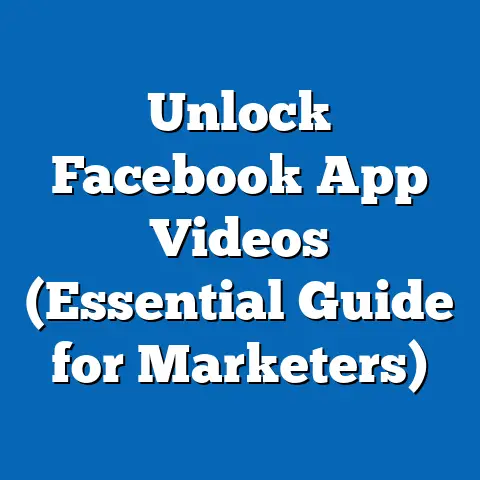Mastering Nationality Targeting in Facebook Ads (Expert Insights)
Have you ever launched a Facebook ad campaign, poured your heart and soul (not to mention your budget) into it, only to see it fall flat? I know I have. It’s a frustrating experience, especially when you realize the message you thought was universally appealing just didn’t resonate. One of the biggest reasons for this disconnect? Failing to account for nationality and cultural nuances.
I remember once working on a campaign for a travel company promoting trips to Europe. We used beautiful imagery of iconic landmarks and generic taglines about “adventure” and “discovery.” The results were… underwhelming. It wasn’t until we dug deeper into the data that we realized our ads were performing significantly better in some countries than others. Why? Because we hadn’t tailored our message to the specific interests and cultural values of each nationality.
According to Facebook’s own data, over 70% of its active users are located outside of the US and Canada. This means that to truly maximize your advertising reach and ROI, you need to master the art of nationality targeting. It’s not just about translating your ad copy; it’s about understanding the unique cultural lens through which different nationalities view the world. In this guide, I’ll walk you through everything you need to know, from understanding the basics to crafting culturally sensitive content and leveraging Facebook’s powerful targeting tools.
Section 1: Understanding Nationality Targeting
Nationality targeting, at its core, is about reaching the right people with the right message. Within the context of Facebook advertising, it means using Facebook’s various targeting options to show your ads to users based on their self-identified nationality, location, language, and even their interests, which often correlate with their cultural background.
Facebook’s algorithms are sophisticated enough to understand a user’s nationality, even if they are currently residing in a different country. This is done by analyzing their profile information, the languages they use, the pages they like, and the content they engage with. This allows advertisers to go beyond simple geographic targeting and truly connect with specific cultural groups.
Why is this so important? Because different nationalities have different values, beliefs, and preferences. What resonates with one group might completely miss the mark with another. For example, an ad featuring individualistic messaging might perform well in the United States, but fall flat in a country with a strong collectivist culture like Japan.
Consider this: a global fast-food chain ran a campaign promoting their new burger. In the US, they focused on the size and affordability of the burger. In India, however, they highlighted the vegetarian options and the fact that the ingredients were locally sourced, catering to the cultural preferences and religious beliefs of the Indian population. This tailored approach resulted in significantly higher engagement and sales in India compared to a generic, one-size-fits-all campaign.
Key Takeaway: Nationality targeting is about understanding the cultural nuances of your target audience and tailoring your message accordingly. It goes beyond simple translation and requires a deep understanding of their values, beliefs, and preferences.
Section 2: The Importance of Cultural Sensitivity
Cultural sensitivity is the cornerstone of successful nationality targeting. It’s about being aware of and respectful of the differences between cultures. A lack of cultural sensitivity can lead to misunderstandings, offense, and ultimately, a failed ad campaign.
Imagine launching an ad campaign in a country where your product or service is considered taboo. Or using imagery that is offensive to a particular religious group. These mistakes can not only damage your brand reputation but also lead to a significant waste of your advertising budget.
Before launching any campaign, I always recommend conducting thorough cultural research. This can involve:
- Surveys: Use online survey tools to gather data on the values, beliefs, and preferences of your target audience.
- Focus Groups: Conduct focus groups with members of your target nationality to get direct feedback on your ad concepts and messaging.
- Social Listening Tools: Monitor social media conversations to understand the topics and trends that are important to your target audience.
- Consult with Cultural Experts: Partner with local experts or cultural consultants who can provide valuable insights into the nuances of your target market.
I’ve seen firsthand how valuable these insights can be. I once worked on a campaign for a skin care brand launching in the Middle East. We initially planned to use the same imagery and messaging that had been successful in Western markets. However, after consulting with a local cultural expert, we learned that certain types of imagery were considered inappropriate and that the focus should be on natural ingredients and traditional beauty practices. We completely revamped our campaign based on these insights, and the results were outstanding.
Here’s an example of a brand that nailed cultural sensitivity: Airbnb. They launched a campaign featuring real people and their homes, showcasing the diversity and inclusivity of their platform. In different countries, they featured different types of homes and different types of people, reflecting the local culture and values. This approach resonated deeply with audiences around the world and helped to build a strong brand reputation.
Key Takeaway: Cultural sensitivity is essential for successful nationality targeting. Invest in thorough research and consult with cultural experts to avoid making costly mistakes.
Section 3: Crafting Targeted Ad Content
Once you have a solid understanding of your target audience’s cultural values and preferences, it’s time to craft ad content that resonates with them. This involves more than just translating your ad copy; it requires adapting your language, imagery, and overall message to align with their expectations.
- Language Localization: Use native speakers to translate your ad copy and ensure that it accurately reflects the nuances of the local language. Avoid using slang or idioms that might not be understood by your target audience.
- Imagery: Choose images that are relevant and appealing to your target audience. Consider using local landmarks, cultural symbols, or people who reflect the diversity of the population.
- Cultural References: Incorporate cultural references that are meaningful to your target audience. This could include references to local holidays, traditions, or famous figures.
- Tone and Messaging: Adapt your tone and messaging to align with the cultural values of your target audience. For example, if you are targeting a country with a strong emphasis on family values, you might want to focus on the benefits of your product or service for families.
I remember working on a campaign for a car manufacturer launching a new SUV in China. We initially planned to use the same ad copy that had been successful in the US, which focused on the car’s performance and off-road capabilities. However, after conducting cultural research, we learned that Chinese consumers were more interested in the car’s safety features and its ability to accommodate large families. We completely rewrote our ad copy to focus on these aspects, and the campaign was a huge success.
Here’s an example of a well-executed ad campaign that utilized localized content effectively: Coca-Cola’s “Share a Coke” campaign. They replaced the Coca-Cola logo with popular names in each country, creating a personalized connection with consumers. This campaign was a global phenomenon, and it demonstrated the power of localization in driving engagement and sales.
Key Takeaway: Crafting targeted ad content requires adapting your language, imagery, and overall message to align with the cultural values and preferences of your target audience.
Section 4: Leveraging Facebook’s Targeting Tools
Facebook offers a wide range of targeting tools that can be used to effectively reach specific nationalities. These tools allow you to target users based on their location, language, interests, and even their connections to specific cultural groups.
Here’s a breakdown of some of the most useful targeting options:
- Location Targeting: Target users based on their current location or their home country. This is useful for reaching people who are traveling or who have recently moved to a new country.
- Language Targeting: Target users based on the language they use on Facebook. This is useful for reaching people who speak a particular language, regardless of their location.
- Interest Targeting: Target users based on their interests, hobbies, and activities. This is useful for reaching people who are interested in a particular culture or nationality.
- Custom Audiences: Create custom audiences based on your existing customer data, such as email addresses or phone numbers. This is useful for reaching people who have already interacted with your brand.
- Lookalike Audiences: Create lookalike audiences based on your custom audiences. This is useful for reaching new people who are similar to your existing customers.
- Multicultural Affinity Targeting: This allows you to target people who have an affinity for a particular culture, even if they don’t belong to that nationality. For example, you could target people who are interested in Japanese culture, even if they are not of Japanese descent.
To set up nationality targeting in Facebook Ads Manager, follow these steps:
- Create a new campaign or ad set.
- In the “Audience” section, select your target location.
- Under “Detailed Targeting,” add interests, demographics, or behaviors related to your target nationality.
- Consider using language targeting to ensure your ads are shown to people who speak the target language.
- Review your targeting options to ensure they are aligned with your goals.
I’ve found that combining multiple targeting options can be particularly effective. For example, you could target users who are located in a particular country, speak a particular language, and are interested in a particular culture. This allows you to create a highly targeted audience that is more likely to engage with your ads.
Key Takeaway: Facebook offers a wide range of targeting tools that can be used to effectively reach specific nationalities. Experiment with different targeting options to find the combination that works best for your campaign.
Section 5: Analyzing and Optimizing Campaign Performance
Once your campaign is live, it’s crucial to track your performance and make adjustments as needed. This involves monitoring key metrics such as engagement rates, click-through rates, and conversion rates across different nationalities.
Here are some key metrics to track:
- Engagement Rate: The percentage of users who interacted with your ad (e.g., liked, commented, shared).
- Click-Through Rate (CTR): The percentage of users who clicked on your ad.
- Conversion Rate: The percentage of users who completed a desired action after clicking on your ad (e.g., made a purchase, signed up for a newsletter).
- Cost Per Click (CPC): The average cost you pay each time someone clicks on your ad.
- Cost Per Conversion (CPC): The average cost you pay for each conversion.
Analyze your data to identify which nationalities are responding best to your campaign. Are there any specific ad copies or visuals that are performing particularly well with certain groups? Are there any nationalities that are not responding well to your campaign?
Based on your findings, make adjustments to your targeting, ad copy, and visuals. Consider A/B testing different ad copies and visuals to find the most effective combination for each target group.
I always recommend setting up conversion tracking to accurately measure the success of your campaigns. This allows you to see which ads are driving the most sales or leads and to optimize your campaigns accordingly.
I once worked on a campaign for an e-commerce company selling clothing. We initially launched a generic campaign targeting users in several European countries. However, after analyzing the data, we realized that our ads were performing significantly better in some countries than others. We then created separate campaigns for each country, tailoring our ad copy and visuals to the local market. This resulted in a significant increase in sales and a much higher ROI.
Key Takeaway: Analyzing and optimizing your campaign performance is crucial for maximizing your ROI. Track key metrics, identify which nationalities are responding best to your campaign, and make adjustments as needed.
Conclusion
Mastering nationality targeting in Facebook ads is essential for any business looking to expand its reach and connect with diverse audiences around the world. It’s about understanding the cultural nuances of your target audience, crafting targeted ad content, and leveraging Facebook’s powerful targeting tools.
While it can be challenging to navigate the complexities of different cultures, the rewards are well worth the effort. By embracing the diversity of your audience and tailoring your message accordingly, you can create more effective ad campaigns, build stronger brand relationships, and ultimately drive more sales.
The landscape of digital advertising is constantly evolving, and it’s more important than ever for marketers to stay ahead of the curve. By mastering nationality targeting, you can position your business for success in the global marketplace. So, take the time to understand your audience, craft culturally sensitive content, and leverage Facebook’s targeting tools. The results will speak for themselves. Good luck, and happy advertising!






